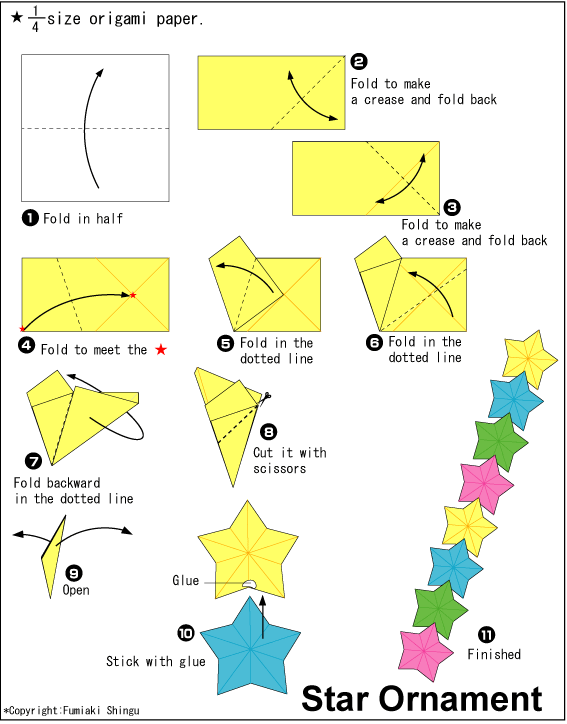

You can use any paper or cardstock, just make sure you cut it into a square. To make these paper stars, I used some handmade paper I bought years ago and had in my scrapbooking paper stash.
#Origami paper star how to#
How to Make a Five-Point, One-Cut Paper Star Step 1Ĭut a square from a piece of paper or cardstock. I made this video tutorial demonstrating origami star instructions, so you can easily master folding paper stars and I have also included a step by step photo tutorial for additional reference. But whatever you call it, folding these paper stars is so fun and so easy you won’t be able to stop once you get the hang of it. So, if you want to get technical about such matters since this five-point folded paper star design uses a cut to complete the design it is actually kirigami, not origami. While original Japanese origami included the use of cuts, modern origami does not include cutting or glue, and folded designs that use cuts are called kirigami. It's just as cute as well ugly Yoda.The word origami comes from the Japanese word “ori” which means “folding”, and kami which means “paper” and while it is generally associated with its Japanese roots, nowadays origami refers to paper folding practices from various cultures. This Yoda comes with a stand that also doubles as his robe. If you're a Star Wars fan, you'll love these easy origami.

I think now you have got pretty much idea about origami and its history, so in this instructable I have shown a very easy Origami Paper Yoda making process. Traditional paper folders believe that only the hands should be used when folding, but many modern folders uses tools like tweezers, rulers, etc. Many paper-folders prefer to use a flat surface to fold models on, but others, like the Japanese, fold in the air. There are also special papers, like textured, metallic, and patterned. Also duo papers or paper with different colors on each side. Pre-cut origami paper is sold in many colors, sizes, and patterns. The best paper for origami is thin and crisp and absolutely square. Hard folds, like the inside-reverse fold, are not allowed in pureland origami. British paper folder John Smith started pureland origami for inexperienced paper-folders or for people with poor motor skills. Pureland origami : is origami with one rule, only one fold can be made at a time.So, many sheets of paper are folded in identical shapes, and they are then put together by inserting flaps into pockets. Modular origami is used to make large structures that cannot be made with one sheet of paper. Modular Origami : is a type of paper folding that uses many sheets of paper.New types of origami have been made because more people are making origami models. His instructions on paper folding are now used in all countries. In 1954, Japanese paper folder Akira Yoshizawa created rules to explain how to fold origami models. Finally, in 1845, Kan no mado was written, and it was the first book of origami models. The earliest evidence of paper folding in Europe is a picture of a boat in 1490. There were also independent paper folding traditions in other countries, like Germany and Spain. People often folded models and gave them to other people for good luck. Instead of making models that looked exactly like things, the first origami models only looked similar to things. It finally came to Japan in the 6th century.

Paper folding started in China in the 1st or 2nd century. The best-known origami model is the Japanese paper crane. Origami folders often use the Japanese word " kirigami" to refer to designs which use cuts. Modern origami practitioners generally discourage the use of cuts, glue, or markings on the paper. The goal is to transform a flat square sheet of paper into a finished sculpture through folding and sculpting techniques. The word Origami is derived from " ori" meaning " folding", and " kami" meaning " paper". Origami is a traditional Japanese art of paper folding.


 0 kommentar(er)
0 kommentar(er)
